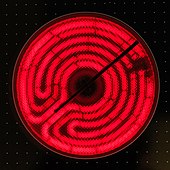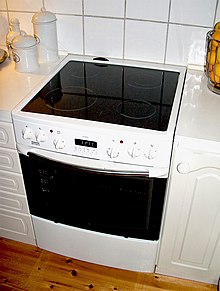Electric stove
An electric stove (short electric stove ) is a large electrical device that is used in kitchens for the preparation or heating of food . The first electric range was introduced at the Chicago World's Fair in 1893 .
The term stove refers to the hotplate at which food is cooked. As a further development of the open fire with smoke extraction, the mostly wood-fired table stove , a combination device with two areas: the hob with the hotplates on top (for heating pots and pans ) and the oven ( the oven ) below (for baking and roasting ). From the table stove for solid fuels, the electrically operated electric stove (and the gas stove ) was further developed.
In modern kitchens, these functions are usually divided into two separate devices. This has the advantage, among other things, that the oven can be installed separately from the hob, for example in an ergonomically favorable high-rise installation. Such a self-sufficient hob is called a hotplate . A distinction is also made between built-in cookers and standing / standing cookers , the latter not being permanently integrated into kitchen furniture.
history
George B. Simpson invented the electric range in the 1850s. He integrated a wire into the plate of a coal stove, which was heated with an electric current . On September 20, 1859 he received a US patent for this electroheater . However, since hardly any households had electricity at that time and since the temperature of the stove could not be regulated except by switching it on and off , only very few copies were in demand. In addition, the stoves were very expensive. As a result, many households preferred a gas stove .
It was not until the 1920s - after many technical developments - that electric stoves spread in the USA and Europe. Electric stoves remained a luxury item until the 1950s. In some European countries, the electric stove has not yet caught on. One reason for this is the high connected load of a four-plate stove of around 10 kW , which overburdens the electrical installation of many households.
connection

In many European countries it is preferred to connect electric stoves to the power grid as a "permanent connection" by means of a stove connection socket ; In Switzerland, however, the wires coming from the conduit are connected directly. A 400 V three-phase alternating current connection is common for the power supply , but single-phase 230 V supplies are also common, especially in older installations.
In Germany, according to the Low Voltage Connection Ordinance, which is part of the contracts between energy supply companies and tariff customers, connection work may only be carried out by a specialist other than by the network operator. In Austria this is provided for by the “Federal Law on Safety Measures, Normalization and Typing in the Field of Electrical Engineering” (Electrical Engineering Act 1992 - ETG 1992). Fatal accidents occur due to electric stoves being connected by laypersons.
See also
Web links
Individual evidence
- ^ Electricity at the World Fair. cooking by electricity. Trove, September 16, 1893, accessed February 25, 2014 .
- ^ Wolfgang Dünkel: Tragic electrical accident at the kitchen stove with fatal consequences. VDE Kassel, March 28, 2011, archived from the original on June 7, 2016 ; accessed on August 31, 2014 .



